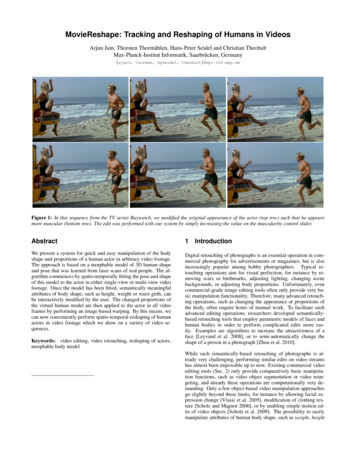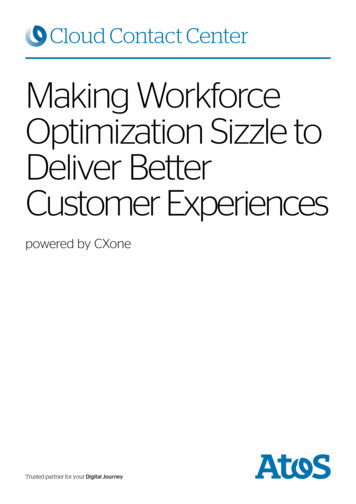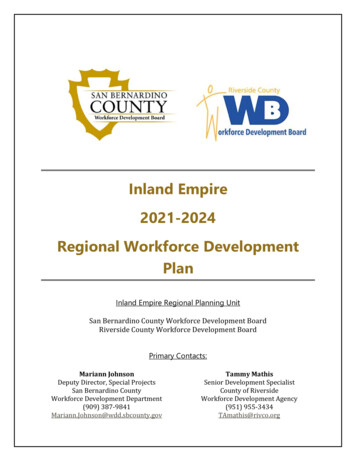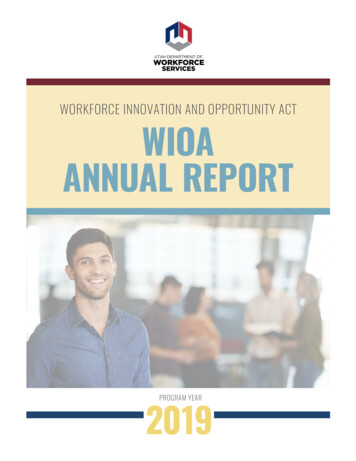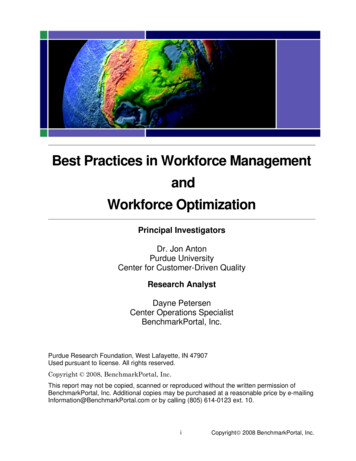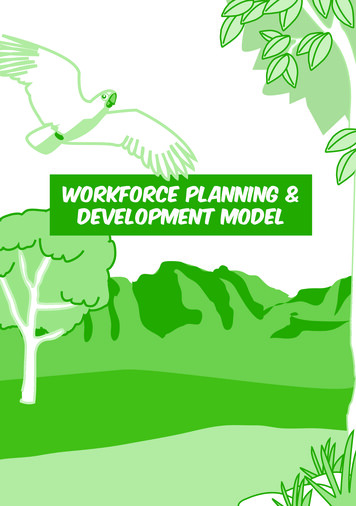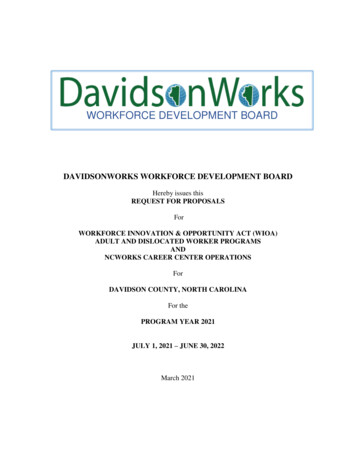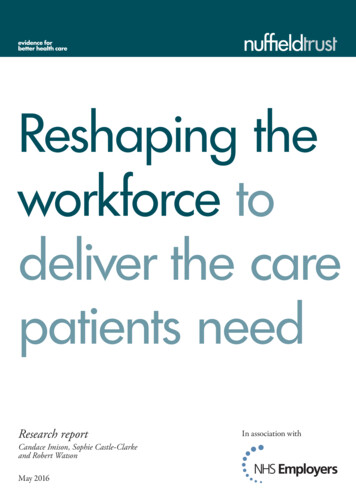
Transcription
Reshaping theworkforce todeliver the carepatients needResearch reportCandace Imison, Sophie Castle-Clarkeand Robert WatsonMay 2016In association with
About this reportHaving the right number of appropriately skilled staff is a critical determinant of thequality and efficiency of health care. Yet there is a growing gap between patient needs andthe skills and knowledge of the workforce that cares for them. This report, which wascommissioned by NHS Employers, gives practical guidance to those wishing to reshapetheir workforce; identifies key enablers and obstacles to change, with lessons for localleaders; and provides recommendations for national and local bodies about key actionsto support change. The report draws on a review of relevant literature, interviews witha wide range of stakeholders, a survey of local Health Education England leaders and anumber of short case studies.AcknowledgementsWe thank the project steering group who were very generous with their time andinsights, and who offered suggestions to improve the report in its near final stages:Daniel Mortimer (CEO, NHS Employers), Sue Covill (Director of Development andEmployment, NHS Employers), John Rogers (CEO, Skills for Health), Prof StephenWelfare (Director, Stephen Welfare Associates Ltd), Garry Swann (Consultant Nurseand Clinical Director, Heart of England NHS Foundation Trust), Patrick Mitchell(Director of National Programmes, Health Education England) and Janet Davies (CEOand General Secretary, Royal College of Nurses). We’re also very grateful to those weinterviewed during the course of the project and to the organisations that agreed to becase study sites. We thank those who, in addition to the steering group, reviewed thereport: Prof Martin Roland (RAND Professor of Health Services Research, University ofCambridge School of Clinical Medicine), Caroline Corrigan (National Workforce Lead– New Care Models, NHS England), Ruth Thorlby (Deputy Director of Policy, NuffieldTrust) and Sue Martin (Interim Director of Communications, Nuffield Trust). Finally,we thank NHS Employers for funding the research.Suggested citationImison C, Castle-Clarke S and Watson R (2016) Reshaping the workforce to deliver thecare patients need. Research Report. Nuffield Trust.Find out more online at: e-workforce
ContentsExecutive summary3List of figures, tables and boxes6Glossary8Foreword91.Introduction102.Context for change – a need to invest in the currentworkforce113.Developing the support workforce174.Extended roles265.Advanced roles386.Physician associates457.Summary of the opportunities from developing thenon-medical workforce538.Summary of the risks from new and extended roles559.How do you reshape the workforce? Lessons forlocal leaders5710. Recommendations for boards64
11. Recommendations for national bodies6612. What does the future hold?7013. Conclusions74Appendix 1: Methods75Appendix 2: Overview of the current health and socialcare workforce77References82About the authors89
3Reshaping the workforce to deliver the care patients needExecutive summaryReshaping the workforce to support new models of care is a huge opportunity, butalso a huge organisational development challenge – particularly with regard to thenon-medical workforce. We argue that organisations need to begin with a deepunderstanding of patient needs, and then train, recruit and skill the workforce tomeet those needs. This report explores how organisations can do this, and the benefitsthat would result. The NHS needs to evolve from an illness-based, provider-led system towards onethat is patient-led, preventative in focus and offers care closer to home. The Five YearForward View sets out an ambition to deliver new models of care that break ‘out of theartificial boundaries between hospitals and primary care, between health and socialcare, between generalists and specialists’ to deliver care that is coordinated aroundwhat people need and want. However, without radical change in the workforce, thisambition will fail. There is an urgent need to reshape the NHS workforce to equip it to meet thechanging demand from the population it serves and deliver the vision set out in theFive Year Forward View. With a workforce of over 1.3 million people, a very smallproportion of whom are fresh from medical or nursing school, this is not just aboutchanging medical or nursing school curricula. There are opportunities to develop the current workforce at all grades: fromredeploying support staff, extending the skills of registered professionals andtraining advanced practitioners. Opportunity also comes from new roles, such asthe physician associate, but the numbers are small. The biggest opportunity to reshapethe workforce lies in developing the skills of the current workforce, particularly thenon-medical workforce. But this presents the NHS with a huge organisational andworkforce development challenge. This report focuses on these opportunities and challenges, but also recognises the vitalimportance of a training pipeline that secures sustainable numbers within all parts ofthe professional workforce. The support workforce is large and highly flexible. And short training times meanthat numbers can be expanded relatively rapidly. There is good evidence thatsupport workers can provide good-quality, patient-focused care as well as reducethe workload of more highly qualified staff. Investment here could provide acost-effective and rapid solution to mitigating some of the pressures on moresenior staff. Support roles can also widen participation by providing a route for thosewho do not have academic qualifications to become professionally qualified. Extending the roles of the non-medical professional workforce providesopportunities to manage the growing burden of chronic disease more efficientlyand effectively. Extending roles can enrich the work of professional staff and maketheir jobs more rewarding. There is some evidence that these new ways of workingcould release some savings and help to bridge the workforce gaps that are forecast,particularly in primary care.
4Reshaping the workforce to deliver the care patients need Advanced practice roles offer opportunities to fill in gaps in the medical workforce;improve clinical continuity; provide mentoring and training for less experiencedstaff; as well as offering a rewarding clinically facing career option for experiencedstaff. The roles can be developed relatively quickly, in around three years. However,developing advanced practice roles can be expensive and if done at scale will require astrong supporting governance structure. Physician associates represent a new cadre of staff with the potential to address anumber of workforce challenges. The training provides a relatively rapid route intothe NHS for graduates keen to undertake a clinical role and opens up a new workforcepool to the NHS. However, the potential numbers in the immediate future arerelatively small. Also, their impact is limited by the lack of a regulatory framework,which prevents physician associates from prescribing and ordering tests. Furthermore,although the training period is short, the role requires an extended period ofsupervision before its full benefits are realised. Reshaping the NHS workforce offers many opportunities. It can deliver benefits forpatients through more patient-focused care and improved health outcomes. It candeliver benefits for staff through more rewarding roles and enhanced career pathways.It can also deliver benefits for NHS organisations through greater efficiencies,helping to address potential workforce gaps and reducing reliance on agency andtemporary staff. However, reshaping the NHS workforce also carries risks. There is evidence thatwithout careful role and service redesign, new and extended roles can:– increase demand– supplement rather than substitute for other staff– cost rather than save– threaten the quality of care– fragment care. We anticipate that, in the future, care will be supplied predominantly by nonmedical staff, with patients playing a much more active role in their own care.Medical staff will act as master diagnosticians and clinical decision-makers. All staffwill be supported by increasingly intelligent medical and information technologies. Large-scale workforce redesign is hard and requires commitment from both nationalpolicy-makers and local leaders. We have identified 10 important lessons fororganisations seeking to redesign their workforce. Local leaders must:– be realistic about the time and capacity needed to support change– create a receptive culture for change– support transformation with a strong communications and change managementstrategy– build roles on a detailed understanding of the work, staff skills and patient needs– invest in the team, not just the role– ensure robust triage mechanisms– develop and invest in a training capability– build sustainability for new and extended roles– evaluate change– adopt a systematic approach to workforce development and change.
5Reshaping the workforce to deliver the care patients need NHS boards need to ‘up their game’ around workforce development and planning.This includes:– ensuring that workforce development (properly resourced) is a central part of thelocal sustainability and transformation plan– providing dedicated senior leadership and front-line staff with protected time tosupport workforce development and planning– putting in place strong supporting systems and governance structures, includingsupervision of the new and extended roles– creating a culture that supports experimentation and change– cultivating links with local workforce and training bodies. There are also a number of important areas where national support is needed. Based onour research we would recommend the following:– the Health Education England budget and specialist workforce planning expertiseshould be protected by ring-fencing monies to support local workforce redesign– national competence frameworks are needed for staff in extended and advancedroles– there should be a dialogue between the professional regulators and systemregulators to ensure that there is no ‘regulatory gap’ and that new and extendedroles have safe governance arrangements– Health Education England should work with NHS Improvement and the CareQuality Commission to ensure that planning assumptions, new workforce modelsand inspection requirements are aligned and clearly communicated– the Department of Health should review the current legal indemnityarrangements for primary care staff with new and extended roles to find ways tomake legal indemnity easier to obtain and more affordable– the underlying needs analysis for, and impact of, workforce redesign should bea national research priority– Health Education England should consider how it can support the disseminationof good practice examples. The financial context in which organisations are currently operating makes thisagenda particularly challenging. There is no headspace in terms of time or resources,yet this is exactly what is needed. National and local training budgets are being cut atthe point that they require expansion. This agenda is not a ‘nice to do’. It is essential if the NHS is to find a sustainablebalance between available funding, patient needs and staff needs.
6Reshaping the workforce to deliver the care patients needList of figures, tables and boxesFiguresFigure 2.1: Breakdown of the NHS workforce in England (number of staff, 000s)11Figure 2.2: Routes to workforce change12Figure 2.3: Overview of the non-medical workforce – estimated distributionacross Agenda for Change pay bands15Figure 9.1: The Calderdale Framework’s seven stages62Figure 11.1: Examples of terminology for new and extended roles67Figure 12.1: Expert views on the scope for workforce redesign in differentservice areas70Figure 12.2: Yorkshire and the Humber – the ‘Toblerone’ model71TablesTable 2.1:Local Health Education England investment in new andextended roles13Table 3.1:Case study summary: band 4 associate practitioners incommunity mental health21Table 4.1:Case study summary: the holistic worker in community care29Table 4.2:Case study summary: paramedic practitioners in theambulance service31Table 4.3:Case study summary: pharmacy and paramedic practitionersin primary care33Table 5.1:Case study summary: advanced clinical practitioners insecondary care41Table 6.1:Case study summary: physician associates in secondary care47Table 6.2:Case study summary: physician associates in mental health49Table A1.1: List of seminar attendees75Table A1.2: Search terms76Table A2.1: Care assistant workforce – Agenda for Change pay bands 1–477Table A2.2: Registered nurse workforce78Table A2.3: Allied health professional workforce78Table A2.4: Pharmacist workforce79Table A2.5: Doctor workforce80Table A2.6: Physician associate workforce81
7Reshaping the workforce to deliver the care patients needBoxesBox 3.1:Community navigators, Southern Health and Social Care Trust,Northern Ireland19Box 3.2:Physical health check tasks undertaken by associate practitioners20Box 3.3:Summary of the opportunities offered by the support workforce22Box 3.4:Summary of the challenges for the support workforce24Box 3.5:Useful resources for developing the support workforce25Box 4.1:Buurtzorg Nederland27Box 4.2:Paramedic practitioner: role description30Box 4.3:Summary of the opportunities offered by extended roles35Box 4.4:Summary of the challenges for extended roles37Box 4.5:Useful resources for extending roles37Box 5.1:Summary of the opportunities offered by advanced roles42Box 5.2:Summary of the challenges for advanced roles43Box 5.3:Useful resources for implementing advanced practitioners44Box 6.1:Useful resources for implementing physician associates50Box 6.2:Summary of the opportunities offered by physician associates52Box 6.3:Summary of the challenges for physician associates52
8Reshaping the workforce to deliver the care patients needGlossaryTermDefinitionAccreditationFormal recognition that a health care organisation or provider is fit to carry out specificactivities or processes in a reliable way.Agenda for ChangeSystem used by the NHS to structure staff pay, whereby individual posts are allocated tobands that correspond to pay scales.Calderdale FrameworkA systematic method for reviewing staff skill mix, developing new roles and identifyingnew ways of working in order to ensure safe, effective care.Care CertificateA set of standards that health and social care workers agree to adhere to in their dailyworking life.Care Quality Commission(CQC)Independent regulatory body that monitors and inspects health and social care servicesin England to ensure they are safe and of sufficient quality.Commissioning forQuality and Innovation(CQUIN)Framework that encourages care providers in England to achieve goals specific to theirlocal area by linking the amount of total funding they receive to their ability to achievethose goals.General Medical CouncilThe regulator of the medical profession, responsible for setting standards in the practiceof medicine, overseeing medical training and providing professional protection fordoctors.Health and CareProfessions Council(HCPC)Independent, UK-wide regulatory body responsible for setting and maintainingstandards of professional training, performance and conduct of health careprofessions.Health Education England Department of Health-sponsored public organisation that exists to educate, train and(HEE)develop the workforce in the health sector.IndemnitySecurity or protection against a loss or other financial burden (e.g. professionalliability).National QualificationsFramework (NQF)A system that sets out the level at which any professional qualification in the UK canbe recognised. This system has now been replaced by the Qualifications and CreditFramework (see entry on this below).Nursing and MidwiferyCouncil (NMC)Independent body that sets standards of education, training, conduct and performancefor the nursing and midwifery professions in the UK.Qualifications and CreditFramework (QCF)System for education qualification in England, Northern Ireland and Wales that setsout the level at which any professional qualification in the UK can be recognised.RegistrationProcess that all health professionals must undergo in order to obtain acknowledgementthat they are fit to practice in a given discipline.RegulationOfficial oversight of the safety and quality of health care professionals’ work bystatutory bodies.
9Reshaping the workforce to deliver the care patients needForewordPatients and their families rightly expect the best that the NHS can deliver, both interms of outcome and experience. An effective workforce where skills and competenceare aligned and support the new service models we need to improve quality, financialefficiency and the long-term wellbeing of our communities is a significant area of focus.That’s why this work that we commissioned from the Nuffield Trust is so important.As the voice of workforce leaders in the NHS, we were keen to investigate where thebalance of opportunity lies between developing new roles and the development of rolesthat already exist. We were also clear that the answers to many of the questions thatare being posed about the future NHS workforce are already being answered in NHSorganisations up and down the country. The challenge is to learn and apply the lessonsfrom these exemplars.Reshaping the workforce to deliver the care patients need therefore provides some veryimpressive specific and practical examples of how the introduction of new roles hasenhanced care. These case studies are central to the conclusions that are drawn. The reportgives very clear and compelling direction on where extending the skills of existing staffcan support service development, and stresses the actions that must be taken to supportfuture innovation elsewhere in the NHS.We will work on behalf of employers in the NHS to make the case for these conclusionsto be acted upon.Daniel Mortimer, Chief Executive, NHS EmployersAlthough it might seem obvious that the success of any health system depends on its staff,the workforce has received very little research or policy attention. It has often been takenfor granted, and we are arguably now paying the price. This is why the Nuffield Trust hasmade the workforce one of its core priorities and why we were so pleased to be asked byNHS Employers to carry out this work.One often hears recommendations to change training approaches or to develop new staff.But our research shows the huge benefits to be obtained – for patients and staff – fromdevelopment of the current non-medical workforce. It also finds that there is a need forinvestment, and that change will need to be carefully managed if the full benefits are tobe realised.A key conclusion emerging from the debate at Nuffield Trust’s recent health policysummit was unashamedly straightforward: ‘It’s the workforce, stupid!’. Developing thecapability and capacity of NHS organisations to create change in this area should be a keypriority for boards. As our work shows, the hard labour of workforce redesign is carriedout at a local level. But delivering the scale of change that is needed safely and sustainablyis complex, and takes time, so it is imperative that national bodies play their part inactively supporting this vision. We hope that this report will help to communicate theseimportant messages far and wide.Nigel Edwards, Chief Executive, Nuffield Trust
10Reshaping the workforce to deliver the care patients need1. Introduction‘We can design innovative new care models, but they simply won’t become a realityunless we have a workforce with the right numbers, skills, values and behaviours todeliver it.’ (NHS England, 2014, pp. 29–30)Having the right number of appropriately skilled staff is a critical determinant of thequality and efficiency of health care. Yet there is a growing gap between patient needs andthe skills and knowledge of the workforce that cares for them. The current workforce wastrained for a model of acute, episodic and single-disease-based care. But those placing thegreatest demands on the health service are people with multi-morbidities, many of whomare old and frail.The NHS needs to evolve from an illness-based, provider-led system towards one that ispatient-led, preventative in focus and offers care closer to home (NHS England, 2014).The Five Year Forward View sets out an ambition to deliver new models of care that break‘out of the artificial boundaries between hospitals and primary care, between health andsocial care, between generalists and specialists’ (NHS England, 2014, p. 6) to deliver carethat is coordinated around what people need and want. Without radical change in theworkforce, this ambition will fail.With a workforce of over 1.3 million people, only 10 per cent of whom are doctors, andonly 0.5 per cent are recent medical graduates, this is not only about changing medicalschool curricula. Reshaping the workforce to support new models of care is a hugeopportunity but also a huge organisational development challenge, particularly withregard to the non-medical workforce. We argue that organisations need to begin with adeep understanding of patient needs, and then train, recruit and skill the workforce tomeet those needs. This report explores how organisations can do this, and the benefitsthat would result.We draw on a review of relevant literature, interviews with a wide range of stakeholders,a survey of local Health Education England (HEE) leaders and a number of short casestudies (see Appendix 1 for a more detailed summary of the methods).The report aims to: give practical guidance and help to those wishing to reshape their workforce identify key enablers and obstacles to change, with lessons for local leaders produce recommendations for national and local bodies about key actions to supportchange.Above all, we hope that the report will help local leaders address the questions posedby the latest NHS planning guidance:‘What is your plan to develop, retrain and retain a workforce with the right skills,values and behaviours in sufficient numbers and in the right locations to deliveryour vision for transformed care? How will you build the multidisciplinary teamsto underpin new models of care? How ambitious are your plans to implement newworkforce roles such as associate nurses, physician associates, community paramedicsand pharmacists in general practice?’ (NHS England, 2015, p. 20)
11Reshaping the workforce to deliver the care patients need2. Context for change –a need to invest in the currentworkforceThere are over 1.3 million people working in the NHS in England, working in over 300different types of jobs (HEE, 2016a). A further 1.45 million people are working in socialcare (Skills for Care, 2015a), the majority in support roles. Figure 2.1 gives a breakdownof the health care workforce for the NHS in England. Over 50 per cent are professionallyqualified clinical staff, while a quarter provide support to clinical staff. In Appendix 2we provide details, for each of the main clinical professional groups, of their numbers,regulatory framework, professional standards, training pathway and pay.Figure 2.1: Breakdown of the NHS workforce in England, 2014 (number of staff )227,619289,887NHS trust central functionsand estates126,440Other GP practice staff73,334Managers and senior managers27,846Doctors and dentists in NHS trusts598,170103,21936,920GPsQualified nurses, midwivesand health visitorsOther qualified scientific,technical and therapeutic staffSupport to clinical staff inNHS trusts314,881143,150289,8870Infrastructure and support100,000Qualified clinical staffSource: Health and Social Care Information Centre (2015a; 2016a)200,000300,000Support to clinical staff
12Reshaping the workforce to deliver the care patients needFigure 2.2 lays out the potential routes to workforce change. Traditional workforceplanning has focused on the training pipeline. However, with only around 8,000doctors graduating from medical school each year, and 30,000 nurses and allied healthprofessionals graduating each year, this would do little to influence the behaviourand ways of working of the current 1.3 million-strong workforce. The majority of thestaff working in the NHS today will still be in it in 10 years’ time, so the developmentand extension of skills within the current workforce needs to be a central part of anyworkforce strategy. New roles, such as physician associates, will also play a part, althoughthe numbers are small. There are currently around 250 physician associates workingin the NHS, with plans to increase this number by over a thousand (HEE, personalcommunication).Figure 2.2: Routes to workforce changeCurrent training pipelineCurrentstaff mixNumbers,roles,skillsSkill flexibilityRole substitutionRole delegationFuturestaff mixSkill developmentNumbers,roles,skillsRole enhancementRole enlargementNew rolesHEE – the body that holds the central training budget for the NHS – is providing somesupport for workforce change. All of the local offices of HEE are investing in new andextended roles (HEE survey findings – See Appendix 1). As Table 2.1 shows, the roles areat all levels and in all health care settings. However, the proportion of HEE’s budget thatis given to this activity is very small. In 2015/16 it amounted to just 4 per cent of HEE’stotal budget – 205 million (HEE, 2015a) – with a prospect of a significant reductionin 2016/17 given the planned cut in HEE’s budget for its general workforce developmentactivities as a result of the spending review (HEE, 2016).
13Reshaping the workforce to deliver the care patients needTable 2.1: Local Health Education England investment in new andextended rolesRole levelRole sectorPercentage of responsesfrom LETBs (N 111)AdvancedAcute care practitionerEmergency care practitionerPrimary care practitioner8.1%6.3%5.4%Assistant practitionerAcute care assistant practitionerCommunity care assistant practitionerMental health assistant practioner5.4%5.4%4.5%Physician’s associateAcute care physician’s associatePrimary care physician’s associateEmergency care physician’s associate5.4%4.5%2.7%ApprenticeAcute care apprenticePrimary care apprenticeMental health apprentice5.4%4.5%3.6%Extended practiceEmergency care extended professional practicePrimary care extended professional practiceAcute care extended professional practice3.6%3.6%2.7%Source: Local HEE leader survey findings (see Appendix 1). LETB Local education and training board.There are two additional challenges that set the context for, and further fuel the need for,workforce change. These are: growing workforce gaps an NHS budget that is failing to keep pace with the health care needs of a growingpopulation.“I’ve got parts of Yorkshire and Humber where I can’t get many GPs and, unless I’mgoing to deliver care from an empty chair, I’ve got to deliver care from a chair withsomebody different in it.” (Mark Purvis, GP Director, Health Education England workingacross Yorkshire and the Humber)Across health and social care, organisations are facing difficulties with recruitment andretention, resulting in a growing use of expensive agency and locum staff.1 There areparticular problems in some areas of nursing and medicine. Turnover rates among newlyqualified nurses are particularly high in both the NHS, at up to 34 per cent (Finlaysonand others, 2002; HEE, 2014), and adult social care, at over 25 per cent (Skills forCare, 2015a). There are forecast gaps in the senior medical workforce in primary care,emergency care, geriatrics and psychiatry, all specialties where the needs are high andgrowing (Imison and Bohmer, 2013). The junior doctor workforce is also declining innumber as the recent expansion in the consultant workforce comes to an end and theexpansion of doctors in training required to deliver this is reversed. This underlines theimportance of the training pipeline as part of an overall workforce strategy. We must planfor levels of training that address gaps created by leavers and changes in patient needs.1. s/2014-10-22/211600/
14Reshaping the workforce to deliver the care patients need“This great interest in the ‘gap’ between registered and health care support workerscoincides with the huge financial pressure that we have in the health service.” (HowardCatton, Head of Policy and International Affairs, Royal College of Nursing)The NHS faces a 22 billion gap in its finances by 2020 (HM Treasury, 2015). Demandfor NHS services, from a growing and ageing population, is projected to rise by 6.6 percent by 2020.1 In social care, a gap between demand and available funding of between 2.8 billion and 3.5 billion will emerge by 2019/20. In many areas, the remainingfront-line staff are left to absorb the rising demand for care into their day-to-dayworkload, a challenge that is magnified as the demand for workforce time is estimatedto be growing at twice the rate of the overall growth in population (CfWI, 2015). Staffburnout is becoming a significant risk in many settings (Clay and Stern, 2015; Hassanand others, 2013).“[W]orkload is a driver in general practice, the BMA [British Medical Association]survey from earlier this year showed a 60 per cent increase in consultations over thelast 10 years, a significant increase, almost doubling of the amount of administrativework we do and trebling of the amount of blood tests and other results that we handle.”(General practitioner)These pressures may create a burning platform for change and innovation, but theyalso risk becoming the dominant drivers of change. We must not lose sight of themore fundamental requirement to adapt the workforce to better support patient andpopulation needs.The focus of
proportion of whom are fresh from medical or nursing school, this is not just about changing medical or nursing school curricula. There are opportunities to develop the current workforce at all grades: from redeploying support staff, extending the skills of registered professionals and training advanced practitioners.



